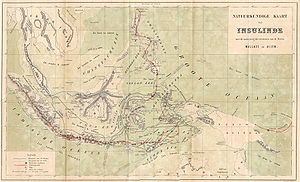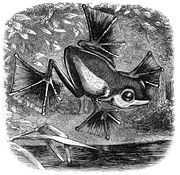
The Malay Archipelago
Encyclopedia


Alfred Russel Wallace
Alfred Russel Wallace, OM, FRS was a British naturalist, explorer, geographer, anthropologist and biologist...
that chronicles his scientific exploration, during the eight year period 1854 to 1862, of the southern portion of the Malay Archipelago
Malay Archipelago
The Malay Archipelago refers to the archipelago between mainland Southeastern Asia and Australia. The name was derived from the anachronistic concept of a Malay race....
including Malaysia, Singapore
Singapore
Singapore , officially the Republic of Singapore, is a Southeast Asian city-state off the southern tip of the Malay Peninsula, north of the equator. An island country made up of 63 islands, it is separated from Malaysia by the Straits of Johor to its north and from Indonesia's Riau Islands by the...
, the islands of Indonesia
Indonesia
Indonesia , officially the Republic of Indonesia , is a country in Southeast Asia and Oceania. Indonesia is an archipelago comprising approximately 13,000 islands. It has 33 provinces with over 238 million people, and is the world's fourth most populous country. Indonesia is a republic, with an...
, then known as the Dutch East Indies
Dutch East Indies
The Dutch East Indies was a Dutch colony that became modern Indonesia following World War II. It was formed from the nationalised colonies of the Dutch East India Company, which came under the administration of the Netherlands government in 1800....
, and the island of New Guinea
New Guinea
New Guinea is the world's second largest island, after Greenland, covering a land area of 786,000 km2. Located in the southwest Pacific Ocean, it lies geographically to the east of the Malay Archipelago, with which it is sometimes included as part of a greater Indo-Australian Archipelago...
. Its full title was The Malay Archipelago: The land of the orang-utan, and the bird of paradise. A narrative of travel, with sketches of man and nature.
Publication and reception
It was first published in 1869 in two volumes by Macmillan and Company (London) and the same year in one volume by Harper & Brothers (New York). It was revised through 10 editions with the last published in 1890. It is considered to be one of the most influential books ever written about the Indonesian islands.A 2000 edition by Periplus
Periplus
Periplus is the Latinization of an ancient Greek word, περίπλους , literally "a sailing-around." Both segments, peri- and -plous, were independently productive: the ancient Greek speaker understood the word in its literal sense; however, it developed a few specialized meanings, one of which became...
uses the original typeset and Wallace's 1890 preface to the tenth edition.
Contents
The preface summarizes Wallace’s travels, the thousands of specimens he collected, and some of the results from their analysis after his return to EnglandEngland
England is a country that is part of the United Kingdom. It shares land borders with Scotland to the north and Wales to the west; the Irish Sea is to the north west, the Celtic Sea to the south west, with the North Sea to the east and the English Channel to the south separating it from continental...
. The first chapter describes the physical geography
Physical geography
Physical geography is one of the two major subfields of geography. Physical geography is that branch of natural science which deals with the study of processes and patterns in the natural environment like the atmosphere, biosphere and geosphere, as opposed to the cultural or built environment, the...
and geology
Geology
Geology is the science comprising the study of solid Earth, the rocks of which it is composed, and the processes by which it evolves. Geology gives insight into the history of the Earth, as it provides the primary evidence for plate tectonics, the evolutionary history of life, and past climates...
of the islands with particular attention to the role of volcanoes and earthquakes. It also discusses the overall pattern of the flora and fauna including the fact that the islands can be divided, by what would eventually become known as the Wallace line
Wallace Line
The Wallace Line separates the ecozones of Asia and Wallacea, a transitional zone between Asia and Australia. West of the line are found organisms related to Asiatic species; to the east, a mixture of species of Asian and Australian origin is present...
, into 2 parts, those whose animals are more closely related to those of Asia and those whose fauna is closer to that of Australia. The following chapters then describe in detail the places Wallace visited. Wallace includes numerous observations on the people, their languages, ways of living, and social organization, as well as on the plants and animals found in each location. He talks about the biogeographic patterns he observes and their implications for natural history
Natural history
Natural history is the scientific research of plants or animals, leaning more towards observational rather than experimental methods of study, and encompasses more research published in magazines than in academic journals. Grouped among the natural sciences, natural history is the systematic study...
, both in terms of biology (evolution
Evolution
Evolution is any change across successive generations in the heritable characteristics of biological populations. Evolutionary processes give rise to diversity at every level of biological organisation, including species, individual organisms and molecules such as DNA and proteins.Life on Earth...
) and the geologic history of the region. He also narrates some of his personal experiences during his travels. The final chapter is an overview of the ethnic, linguistic, and cultural divisions among the people who live in the region and speculation about what such divisions might indicate about their history. The book is dedicated to Charles Darwin
Charles Darwin
Charles Robert Darwin FRS was an English naturalist. He established that all species of life have descended over time from common ancestry, and proposed the scientific theory that this branching pattern of evolution resulted from a process that he called natural selection.He published his theory...
.
Influence on later works
Joseph ConradJoseph Conrad
Joseph Conrad was a Polish-born English novelist.Conrad is regarded as one of the great novelists in English, although he did not speak the language fluently until he was in his twenties...
was very impressed with the Malay Archipelago, and used it as source material for some of his novels including Lord Jim
Lord Jim
Lord Jim is a novel by Joseph Conrad originally published as a serial in Blackwood's Magazine from October 1899 to November 1900.An early and primary event is Jim's abandonment of a ship in distress on which he is serving as a mate...
. More recently it has influenced a number of books including:
- The Song of the Dodo by David QuammenDavid QuammenDavid Quammen is a science, nature and travel writer whose work has appeared in publications such as National Geographic, Outside, Harper's, Rolling Stone, and The New York Times Book Review....
published in 1996, which discusses Wallace’s Indonesian explorations in the context of the development of the scientific discipline of island biogeography. - The Spice Islands Voyage by Tim SeverinTim SeverinTim Severin is a British explorer, historian and writer. Severin is noted for his work in retracing the legendary journeys of historical figures. Severin was awarded both the Gold Medal of the Royal Geographical Society and the Livingstone Medal of the Royal Scottish Geographical Society...
, which was published in 1997, and was subtitled The Quest for Alfred Wallace, the Man Who Shared Darwin's Discovery of Evolution attempts to retrace Wallace's travels. - Archipelago: The Islands of Indonesia: From the Nineteenth-Century Discoveries of Alfred Russel Wallace to the Fate of Forests and Reefs in the Twenty-First Century, by Gavan Daws and Marty Fujita, published in 1999, which uses Wallace's observations as a baseline of comparison to better understand environmental issues in modern Indonesia.
See also
- WallaceaWallaceaWallacea is a biogeographical designation for a group of Indonesian islands separated by deep water straits from the Asian and Australian continental shelves. Wallacea includes Sulawesi, the largest island in the group, as well as Lombok, Sumbawa, Flores, Sumba, Timor, Halmahera, Buru, Seram, and...
- Wallace LineWallace LineThe Wallace Line separates the ecozones of Asia and Wallacea, a transitional zone between Asia and Australia. West of the line are found organisms related to Asiatic species; to the east, a mixture of species of Asian and Australian origin is present...
- Operation WallaceaOperation WallaceaOperation Wallacea is an organisation funded by tuition fees that runs a series of biological and conservation management research programmes operating in remote locations across the world...
- Fauna of Indonesia
- Flora of Indonesia

